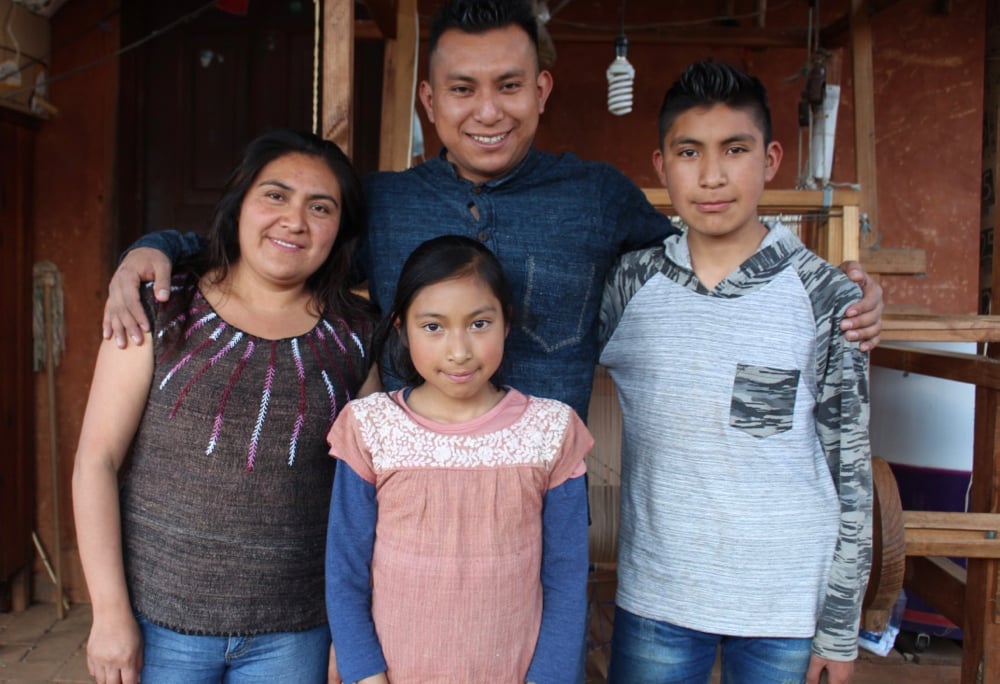Welcome to DU!
The truly grassroots left-of-center political community where regular people, not algorithms, drive the discussions and set the standards.
Join the community:
Create a free account
Support DU (and get rid of ads!):
Become a Star Member
Latest Breaking News
General Discussion
The DU Lounge
All Forums
Issue Forums
Culture Forums
Alliance Forums
Region Forums
Support Forums
Help & Search
Latin America
Related: About this forumFor Indigenous Zapotec Families, Spinning Becomes a Lifeline

Marciano Vargas Ramírez, extended family member of Khadi Oaxaca co-founder, Eliseo "Cheo" Ramírez, working a pedal loom. Many weavers at Khadi Oaxaca once immigrated to the city or to the U.S. to earn a living. Now they can work from home, together with their families.
PHOTOS BY TRACY L. BARNETT
The COVID-19 pandemic has hurt communities all over Mexico. But a network of Indigenous artisans is finding a way to survive during the shutdown.
BY TRACY L. BARNETT
10 MIN READJUN 17, 2020
High up in the southern sierra of Mexico’s state of Oaxaca, an innovative nonprofit business inspired by Mohandas Gandhi is helping Indigenous Zapotec families to weather the economic storm that COVID-19 has brought to the Mexican countryside.
San Sebastian Rio Hondo, a Zapotec highland village like many others, has traditionally supplemented its agrarian way of life through the wool industry. Long famous for its rich tradition of Indigenous handwoven textiles, Oaxaca has nevertheless fallen on hard times, along with most of rural Mexico, partly because of policies promoting urbanization and undermining the traditional rural way of life.
In San Sebastian, the hardship has been severe: as of the 2010 census, 55% of the population lived in extreme poverty, more than a third had not completed primary school, and more than two-thirds did not have a high school education. Unemployment continues to be high, compelling a high rate of migration out of the state and out of Mexico. Among the women, job opportunities were practically nonexistent.
This was the context that Eliseo “Cheo” Ramírez was born into. In his parents’ and grandparents’ time, villagers grazed sheep and helped cover expenses by making woolen textiles. In the 1970s and ’80s, however, the Mexican government initiated a program to plant pine trees for lumber, and the pastures and native forests began to shrink. The industrial clothing industry began producing cheap synthetic yarns. Spinning and weaving, once a staple in every home, fell by the wayside. The children of weavers and farmers began making their way north to work in the U.S. as meatpackers and migrant farmworkers.

The Ramírezes, co-founding family of Khadi Oaxaca. Clockwise from center, Eliseo “Cheo,” Giovani, Diana and Felipa. Photo by Tracy L. Barnett.
More:
https://www.yesmagazine.org/economy/2020/06/17/coronavirus-mexico-indigenous-families-handspun-thread/?utm_source=feedburner&utm_medium=feed&utm_campaign=Feed%3A+yes%2Fmost-recent-articles+%28YES%21+Magazine+Most+Recent+Articles%29
InfoView thread info, including edit history
TrashPut this thread in your Trash Can (My DU » Trash Can)
BookmarkAdd this thread to your Bookmarks (My DU » Bookmarks)
2 replies, 571 views
ShareGet links to this post and/or share on social media
AlertAlert this post for a rule violation
PowersThere are no powers you can use on this post
EditCannot edit other people's posts
ReplyReply to this post
EditCannot edit other people's posts
Rec (2)
ReplyReply to this post
2 replies
 = new reply since forum marked as read
Highlight:
NoneDon't highlight anything
5 newestHighlight 5 most recent replies
= new reply since forum marked as read
Highlight:
NoneDon't highlight anything
5 newestHighlight 5 most recent replies
For Indigenous Zapotec Families, Spinning Becomes a Lifeline (Original Post)
Judi Lynn
Jun 2020
OP
When I saw the title of above article at another website, I strained to see the article,
Judi Lynn
Jun 2020
#1
Judi Lynn
(160,516 posts)1. When I saw the title of above article at another website, I strained to see the article,
believing when I got there I would be seeing the following people. Imagine my surprise! I am very glad to become aware of two kinds of "spinners!"
Dance of the Flyers - Voladores at Teotihuacán, Mexico
23,779 views•Apr 19, 2012
Dance of the Voladores at Teotihuacán, an ancient commercial and religious center in the central valley of Mexico. The Danza de los Voladores (Dance of the Flyers), or Palo Volador (Pole Flying), is an ancient Mesoamerican ceremony/ritual still performed today, albeit in modified form, in isolated pockets in Mexico and Guatemala. It is believed to have originated with the Nahua, Huastec and Otomi peoples in central Mexico, and then spread throughout most of Mesoamerica. The ritual consists of dance and the climbing of a 30 meter pole from which four of the five participants then launch themselves tied with ropes to descend to the ground. The fifth remains on top of the pole, dancing and playing a flute and drum. According to one myth, the ritual was created to ask the gods to end a severe drought. Although the ritual did not originate with the Totonac people, today it is strongly associated with them, especially those in and around Papantla in the Mexican state of Veracruz. The ceremony was named an Intangible Cultural Heritage by UNESCO in order to help the ritual survive and thrive in the modern world.
Danza de los voladores en Teotihuacán, un antiguo centro comercial y religioso en el valle central de méxico. la danza de los voladores; danza de los voladores, o palo volador volando, es una antigua ceremonia mesoamericano.
Video as seen through the eyes of a "Flyer":
3:38 / 9:22
Espectacular video de los "Voladores de Papantla" (Vuelo completo HD-GoPro)
Ritual Ceremony of the Voladores - Glastonbury festival 2015
niyad
(113,259 posts)2. Thank you so much for posting.